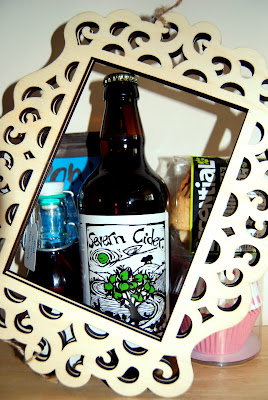My penpal this month was Lina from Lithuania. After a brief email exchange to check out likes, dislikes, dietary requirements etc, I learned that Lina loves chocolate, but is on a health food kick at the moment, so no processed foods for her! She loves tea and coffee and enjoys baking. But she was really happy to receive anything new and interesting.
I wanted to put together a box of local ingredients for Lina, but being new to Bristol I had to go on a bit of a discovery mission myself, both in terms of local gastronomy and shops at which to spend my £10. This general part of the country is big on apples and cider. But other than that, and with the limitations of sending perishables to Eastern Europe, I found myself a little stumped, particularly as I am a savoury rather than sweet kind of person.
Still, I think I put together an interesting little box. I found dried apples, local chocolate and regional cider in the Southville Deli, a local health food shop and cafe. And then I topped the box up with some pretty cupcake cases and a bottle of maple syrup - because you can do so much with maple syrup!
Along with the box, I sent Lina a postcard with the famous Bristol hot air balloons with a little explanation of all the items in the box and a few suggestions on how to use the maple syrup and cider. I also sent her a recipe for Apple Cider Cake with Marscapone from the BBC Food website, so that she could use the ingredients for some baking.
It's all sounding pretty great, right? Well, Lina put me to shame. She asked me what I liked, and I told her that I liked savoury things, and was really willing to try anything and everything. With such a vast range of possibilities, she asked me to narrow it down a little for her and let her know what my favourite things were. That's easy. Cheese. And cured meats. I'd die happy if that were my last meal.
My box from Lina contained a variety of cheeses, meats and spices, including:
Dvaro (a dried curd cheese);
Su Kmynais (a smoked goats cheese);
Shashlik spice (onion, mustard, paprika, black pepper, tomato, basilica, oregano, thyme, marjoram, chilli & parsley);
Lizdeikos (a cured beef sausage); and
Baravykai (dried boletus - a type of mushroom)
Thankfully, Lina had put little notes on all of the items so that I knew what they were and the ingredients. I have been nibbling at the cheese and meat (to make it last longer!). And last night I used the spice mixture on some lamb kebabs - Lina recommended that I use the spice on something cooked over fire. Well, it wasn't quite fire, but I did use a griddle pan... I made a minty tzatziki and a tomato, red spring onion and oregano salad with balsamic dressing to load up the wraps before adding the spiced lamb. It was a fab summer dinner.
 |
| Lamb Kebabs with Shashlik from Lithuania |
With such an amazing introduction to Lithuania, I need to get myself over there - well, when all the studying, marrying, buying a house etc is finished with! I can't wait for next month of my penpal experience.


.JPG)



